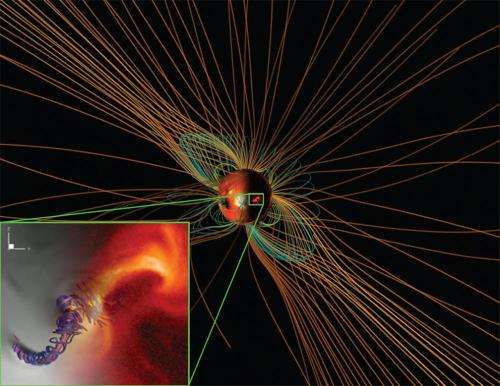Scientists shed light on riddle of Sun's explosive events

(Phys.org)—Four decades of active research and debate by the solar physics community have failed to bring consensus on what drives the sun's powerful coronal mass ejections (CMEs) that can have profound "space weather" effects on Earth-based power grids and satellites in near-Earth geospace.
In a paper just published in Nature Physics, an international team of space scientists, including a researcher from the University of New Hampshire's Space Science Center (SSC), explains the mysterious physical mechanisms underlying the origin of CMEs. Their findings, based on state-of-the-art computer simulations, show the intricate connection between motions in the sun's interior and these eruptions and could lead to better forecasting of hazardous space weather conditions.
CMEs are clouds of magnetic fields and plasma – a hot gas composed of charged particles. The fastest and most powerful of these events can explode from the sun at speeds of more than a million miles per hour and release more energy than the current worldwide stockpile of nuclear weapons.
"By studying CMEs we learn not only about the drivers of space weather but also about the structure of the atmosphere of the sun and other sun-like stars," says lead author Ilia Roussev of the Yunnan Astronomical Observatory, Chinese Academy of Sciences (CAS) and the Institute for Astronomy at the University of Hawaii at Manoa.
Geomagnetic storms caused by CMEs can disrupt power grids, satellites that operate global positioning systems and telecommunication networks, pose a threat to astronauts in outer space, lead to rerouting of flights over the polar regions, and cause spectacular auroras. The storms occur when a solar eruption hits Earth's protective magnetic bubble, or magnetosphere.
The Nature Physics paper, titled "Explaining fast ejections of plasma and exotic X-ray emission from the solar corona," provides an explanation of the origin of fast ejections of magnetized plasma from the sun's atmosphere and associated X-ray emissions. It thus demonstrates a fundamental connection between the magnetic processes inside the sun's interior and the formation of CMEs.
"Through this type of computer modeling we are able to understand how invisible bundles of magnetic field rise from under the surface of the sun into interplanetary space and propagate towards Earth with potentially damaging results", says SSC researcher Noé Lugaz of the UNH Institute for the Study of Earth, Oceans, and Space. He adds, "These fundamental phenomena cannot be observed even with the most advanced instruments on board NASA satellites but they can be revealed by numerical simulations."
A long-standing goal of the solar physics community has been the forecasting of solar eruptions and predictions of their impact on the Earth. In the paper, the authors note, "the model described here enables us not only to capture the magnetic evolution of the CME, but also to calculate the increased X-ray flux directly, which is a significant advantage over the existing models."
More information:
The Nature Physics paper can be viewed at
www.nature.com/nphys/journal/v … nt/pdf/nphys2427.pdf
Journal information: Nature Physics
Provided by University of New Hampshire




















